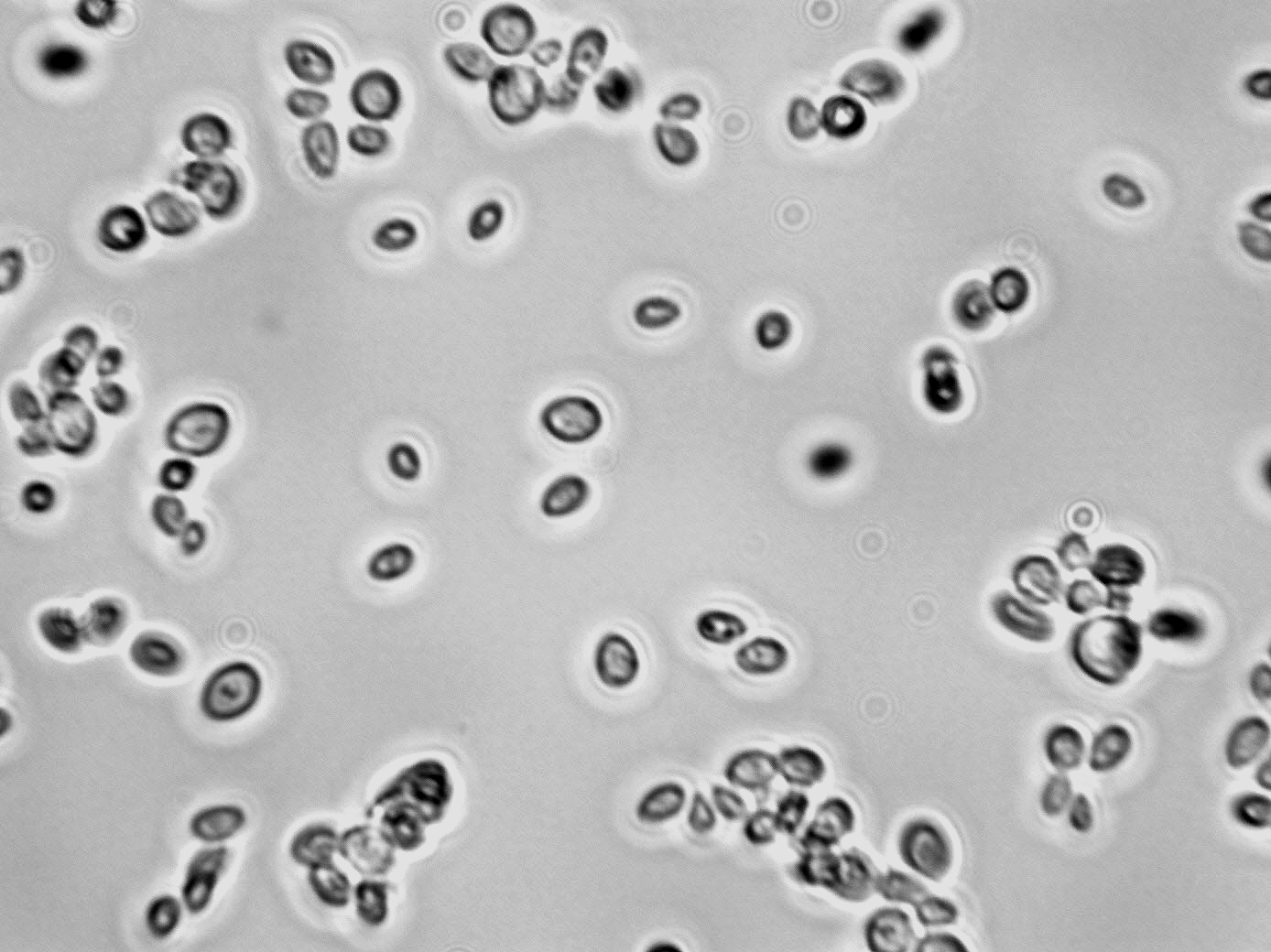Genus/species (aliases): Metschnikowia pulcherrima (Candida pulcherrima, anamorph;Torula pulcherrima, Torulopsis pulcherrima, Rhodotorula pulcherrima, Saccharomyces pulcherrimus, Cryptococcus castellanii.
Classification: Ascomycete, teleomorph
Morphology:
- Cell: reproduces by budding; ovoid to ellipsoidal; pulcherrima cells formed: globose, thick-walled, contain a single, large oil droplet, and are highly refractile; pseudohyphae may be formed under anaerobic conditions.
- Colony: Cream-colored colonies, produce a reddish-brown soluble pigment, pulccherimin that can color colonies and diffuse into the medium.
- Malt agar: Slow growing.
- WL (Wallerstein Laboratory Nutrient Agar): Grows very well. WL is a media designed for the wine and brewing industry for culturing yeast.
- Spore: one to two acicular to filiform (spear-shaped) spores may form
- Zygote: Chlamydospores.
- Ascus: arise from spheriodial chlamydospores, which contain a single lipid globule; asci are spheropedunculate.
 |
 |
 |
 |
Physiological Traits:
- Fermentation: Glucose; variable: Galactose
- Assimilation: Galactose, Sucrose, Maltose, Melezitose, Cellobiose, Trehalose, D-Xylose, Ribitol, Mannitol, Succinate, Glucitol, Mannitol, variable: Sorbose, Salicin, Arbutin, Citrate, Succinate, Ethanol; No assimilation of nitrate or nitrite; Cadaverine used as sole N source; variable use of Ethylamine, Lysine, tryptophan as sole N source; No growth on vitamin-free medium, requires biotin
- Growth: 37 C: variable
- Growth Sensitivities: 10% NaCl: +; grows on high glucose concentrations; not cycloheximide resistant
The growth substrate is mainly glucose and other sugars. The end products at alcohol, lipase, and a water-soluble red pigment called pulcherrimin that has antimicrobial effects on undesired microorganisms.
Ecological Traits:
The yeast occurs in terrestrial habitats, especially on fruit, in flowers and in nectars. The yeast can persist on winery equipment leading to subsequent inoculations if the equipment is not properly sanitized.
Distinguishing Features:
Cultures may readily be recognized as diploid by the formation of asci and ascospores under specific cultural conditions, always from a single cell without prior conjugation and in species with a known heterothallic haploid stage, by the absence of zygote formation when mixed with such haploids. In M. pulcherrima and M. reukaufii, by the presence of distinctive ascus mother cells, commonly termed chlamydospores are also distinguishing features. The production of pulcherrima cells and the pigment pulcherrimin is a unique attribute to Metschnikowia. Under abnormal environmental conditions for the yeast, pulcherrima cells may function as chlamydospores and then revert to vegetative cells. The dual role of pulcherrima cells, functioning both as chlamydospores and as ascus mother cells, is unique among the yeasts (Pitt, 1970). Ascospores yeasts produce relatively long fimbriae (1-5 /Am). Plating on WL media is an effective method to analyze non-Saccharomyces yeast activity. The colonies that appear on the media should be observed through a microscope to look for the features discussed above.
Role in wine:
Metschnikowia pulcherrima is a non-Saccharomyces yeast that may be involved in the vinification of wine if present on the grapes or winery equipment at crush. Non-Saccharomyces yeasts will begin fermentation before the populations ofSaccharomyces yeast have established a sufficient cell density to overwhelm the non-Saccharomyces yeast. Non-Saccharomyces yeasts tend to be viewed as favorable to fermentations to allow for added flavor to the wine. They begin fermentations faster to help to prevent other unfavorable organisms from becoming established prior to the end of the lag period of Saccharomyces. They will be able to ferment wine until the alcohol content reaches 5%, where their sensitivity to ethanol prevents further metabolism and causes a die off of all yeast species besides Saccharomyces. Saccharomyces is responsible for all wine fermentations after 5% ethanol.
Acid proteases secreted by Kloeckera apiculata, Metschnikowia pulcherrima, and Torulaspora magnolia were found to be effective at the degradation of wine proteins in both wine and model solutions [Lagace,1990].This suggests that if present in to high of a concentration the overall sensory qualities of the finished wines may be effected by the non-Saccharomyces yeast.
Sensitivities:
- SO2: Inhibits growth of yeast, but molecular signatures of non-Saccharomyces yeasts can remain in wine fermentations treated with SO2 long after those populations become nonculturable (Cocolin, 2003)
- Sorbate: It is not sensitive to sorbate
- DMDC: Inhibits for 12 h and then no residual inhibitory effect. It is most effective at temperatures below 30C.
- pH: The yeast can tolerate low pHs, but pH over 7 is inhibitory and a pH over 3.6 allows for competition from bacteria and other microorganisms.
- Acids: It is not particularly sensitive to organic acids.
- Ethanol: The yeast can tolerate ethanol until the media reaches a concentration in excess of 5%, then Metschnikowia begins to die off and Saccharomyces takes over fermentation.
- Anaerobiosis: Minimum water activity permitting growth. Oxygen is required for metabolism of yeast, so lack of oxygen is inhibitory.
- Temperature: Maximum temperature for growth is around 39 C. The upper temperature limit for sporulation of Metschnikowia pulcherrima lies below 25 C on all but the most favorable media.
References:
- Cocolin, Luca, Mills, David A. Wine Yeast Inhibition by Sulfur Dioxide: A Comparison of Culture-Dependent and Independent Methods Am. J. Enol. Vitic. 2003 54: 125-130.
- Fernández M, Ubeda JF, Briones AI., Typing of non-Saccharomyces yeasts with enzymatic activities of interest in wine-making. Int J Food Microbiol. 2000 Jul 25;59(1-2):29-36.
- Lagace, L., and L. F. Bisson. Survey of yeast acid proteases for effectiveness of wine haze reduction. Am. J. Enol. Vitic. 1990 41:147-155.
- Naturforsch, Z, C. S, Ener, B. Türkel, Isolation and characterization of new Metschnikowia pulcherrima strains as producers of the antimicrobial pigment pulcherrimin. 2009 May-Jun; 64(5-6):405-10. Department of Biology, Faculty of Arts and Sciences, Uludag University.
- Pitt J. I.,M. W. Miller, The Parasexual Cycle in Yeasts of the Genus Metschnikowia. Mycologia, Vol. 62, No. 3 (May - Jun., 1970), pp. 462-473.
- Pitt J. I.,M. W. Miller, Sporulation in Candida pulcherrima, Candida Reukaufii and Chlamydozyma Species: Their Relationships with Metschnikowia. Mycologia, 1960. Vol. 60, No. 3, pp. 663-685 .
